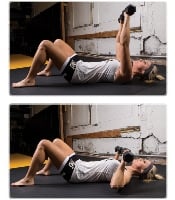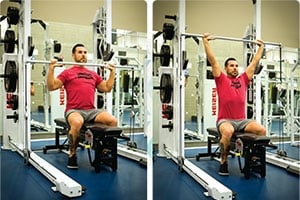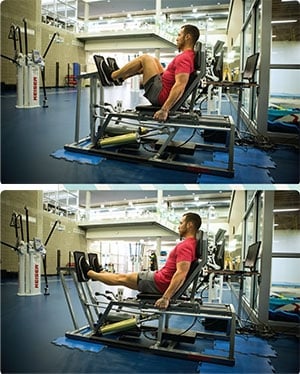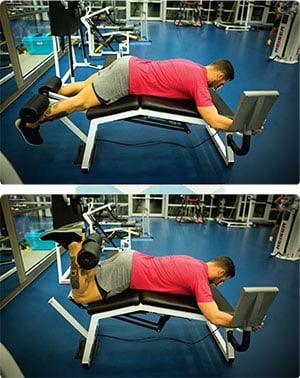
Newcomer in a gym full of machines? No problem! Discover why using resistance machines is so helpful, while learning exercises for the total body. You’ll feel ready to hit the weights in no time.
Newcomer to the gym? The machines, noise, and smells can be overwhelming, but there’s no need to fear. Once you get used to all the metal and chrome, pulleys and pins, you’ll realize that weight machines can be a useful tool on your road to health and fitness.
Different brands may have a slightly altered look or feel, but similar machines target the same muscles in the same ways. Learn the movement patterns you should be engaging in, and everything falls into place.
Why work with machines?
You’ll see stacks of free weights and bars with plates to load on them in the gym, as well as a variety of static machines. Why choose the machine over the free weight when first starting out?
Support
If you’ve never exercised in a gym before, your body awareness will be less than that of a veteran exerciser. Your stability and balance may be shakier, and your accessory muscles probably aren’t as strong. All of these factors push toward using machines.
Reminders
The learning curve is steep when you start out, so why have more things to remember than you need to? Most machines have labels with their name (which you can write down for future reference), as well as some tips on form in case you forget.
His and hers
Most machines are designed for men. However, if you’re in a ladies-only gym, machines will likely be built for female bodies.
Safety
If you have joint injuries, machines can be safer by keeping you within a limited range of motion. There is less risk of dropping a weight on your foot, and you won’t have to put weights down between sets.
Efficiency
Most machines have seats that you can quickly adjust according to your height or limb length. Changing the weight is easy—just move the pin! No need to add plates to bars; this is much more time efficient.
Form
Just because you’re using machines doesn’t mean you don’t need to worry about your form. Using proper posture and alignment will make you do the exercise correctly and prevent injuries down the road. Consider going through a program with a personal trainer to improve your form.
Some of the top ways to keep your form include
- keeping your core engaged
- not locking your joints or leaning forward
- keeping your head in alignment with your spine
Disease or injury
If you’re worried about starting a machine program at the gym because you’re suffering from an ailment like arthritis, tendonitis, or another -itis, speak with your health care practitioner. You may be surprised at the number of machines that could benefit you.
Of course, you will want to avoid certain movements (such as leg curls and extensions if you have severe arthritis or an injury in your knees), but you can likely do a variety of other exercises to work the rest of your body. Ask gym personnel if you’re unsure about an exercise machine.
Stationary machines are pieces of equipment that you sit in or on; they include lat pull-down, chest press, leg extension, leg curl, and tricep push-down machines.Pulley systems are housed in a tower with adjustable attachments for pulling, pushing, and pressing. You will be able to lift different amounts with a pulley system than with stationary machines. Adjusting pulleys can let you work your whole body in one place, which is very time efficient.
Pneumatic equipment is air-powered. Instead of moving a pin, you simply push a button on the handle to increase or decrease the resistance, which stays uniform throughout the movement. It doesn’t get much simpler than that for a new exerciser.
Five basic machine exercises
Seated chest press

- Adjust the seat according to your height—hands should be just below shoulder height when handles are pulled in.
- Set the weight.
- Sit down and grasp the handles (some machines require you to push a lever with your foot to extend the handles).
- Keeping your back against the seat and core engaged, bring the handles to shoulder level, then push out. Repeat.
Top tip: Make sure to keep your elbows at 90 degrees when you flex your arms to prevent strain on the shoulder joints.
Seated lat pull-down

- Set the weight (see “Importance of sets and reps” sidebar for how to choose your weight).
- Sit down and grasp the handlebar with both hands. Start with a narrow grip; wider is more difficult.
- Lean back slightly and pull the bar toward your sternum, keeping your core engaged.
- With control, allow your arms to return to starting position, and repeat.
Top tip: Make sure your head doesn’t bob back and forth when you pull the bar down—keep your spine long and your head neutral.
Seated shoulder press

- Adjust the handles and seat according to your height; hands should be around shoulder height when grasping the handles, and feet should be flat on the floor or footrests.
- Set the weight.
- Grasp the handles and engage your core. Keep your back against the seat and push your hands up over your head until arms are straightened.
- Release weight down slowly, and repeat.
Top tip: Keep your posture perfect: arched or rounded backs will lead to pain later on.
Leg press

- Get into the seat and adjust your body so that your legs are just past 90 degrees. Your feet should be parallel and under your hips (not wider or more narrow).
- Adjust the weight accordingly.
- Press your legs forward or push your body back (depending on the leg press machine) until your legs are straight, but your knees do not lock.
- Return to starting position. Repeat.
Top tip: Keep your knees slightly bent at the end of the leg press. Never lock your joints.
Leg curl

- Adjust the seat and foot pad according to your height. (Some leg curls are seated, others are prone.) You want the top of the back of your shoe to sit at the heel pad; the pad should not be on your calves or heels.
- Set the weight.
- Place your feet under the heel pad if prone (over the pad if seated).
- Curl your heels to your bum, keeping your core engaged.
- Release legs to starting position with control, and repeat.
Top tip: Don’t arch your back when you bend your legs.
Importance of sets and reps
A set is a group of repetitions (reps) of an exercise. One set can be any number of reps, but for muscular endurance when you’re beginning, you should stick to two to three sets of 12 to 15 reps. If you can do many more than that, the weight is probably too light. If you can’t do that many, the weight is probably too heavy.
It’s best to follow a specific number of sets and reps so that you can build up endurance and each exercise is uniform.
